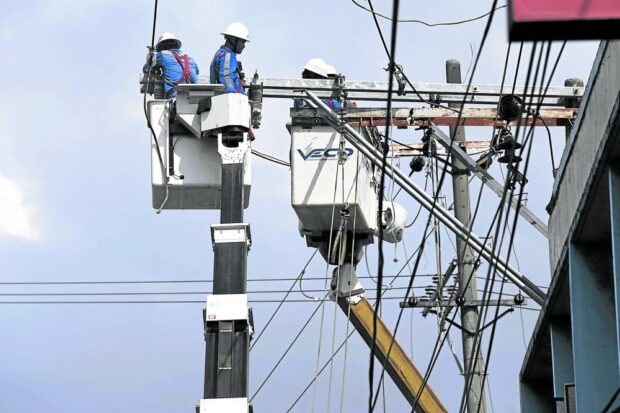NGCP: Visayas needs more power plants

LINE CHECK A maintenance crew from Visayan Electric Co., in this 2017 photo, checks power lines in Cebu City to ensure continuous electricity supply in the city’s business and residential areas.
—CDN FILE PHOTO
CEBU CITY — The National Grid Corporation of the Philippines (NGCP) is calling for the construction of new power plants in the Visayas to address the increase in power demand in the region.
Lawyer Cynthia Alabanza, NGCP assistant vice president and head for public affairs, said additional power plants are important to boost existing capacity, establish reserves, and meet the anticipated boom in investments and population.
She particularly cited Cebu which, she said, has enough power supply but where reserves are getting thin as the demand rises due to more industries and business activities.
“All roads lead to Cebu when we talk about power consumption in the Visayas. Cebu needs more power plants,” Alabanza said in a recent interview.
Even during the COVID-19 pandemic, she said there was still a rise in power demand in Cebu.
“Now, with the economy fully reopening, we are witnessing a substantial surge in power requirements,” she said.
On Dec. 18, the Visayas grid only had 241 megawatts (MW) of power reserves—way too low compared to Luzon’s 2,532 MW and Mindanao’s 960 MW.
Rising demand
The entire Visayas grid has a generating capacity of 2,449 MW while demand is pegged at 2,209 MW. The island of Cebu accounts for half of the region’s total demand.
Metro Cebu alone needs at least 500 MW daily or about half of the province’s demands.
Abner Bardoquillo, NGCP network operations senior manager for Visayas systems operations, said Cebu needed to build more “inland” power plants to attain self-sufficiency in electricity supply.
With the rising growth in investments and population, he said Cebu had to generate its power supply without relying on outside-of-province sources, especially during emergencies.
The Department of Energy and the NGCP previously cited Cebu as among the main sites for large generation capacity additions.
Before the pandemic, the National Economic and Development Authority identified the potential of Cebu for new investments in heavy and extractive industries.
This includes shipbuilding and other allied activities in the western seaboard of Cebu; car manufacturing and car parts manufacturing; aerospace parts; resource-based industries; and fabricated metals.
The business sector also expressed concern over the increase in the cost of power in Cebu by next year without the new power plants.
Felix Taguiam, former president of the Cebu Chamber of Commerce and Industry, said resolving Cebu’s power cost challenges would hinge on the province’s ability to independently meet its energy demand.
READ: Audit of NGCP facilities starts as power outlook brightens